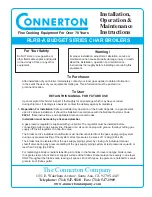
Part number 550-143-010/1021
70
GV90+
series
2
gas-fired water boiler – boiler manual
Inspect expansion tank
1. Expansion tanks provide space for water to move in and out as
the heating system water expands due to temperature increase or
contracts as the water cools. Tanks may be open, closed or dia-
phragm or bladder type. See
of this manual for suggested
location of expansion tanks and air eliminators.
• Open-type — located above highest radiator or baseboard
unit, usually in the attic or closet. Has a gauge glass and over-
flow pipe to a drain.
• Closed-type — welded gas tight and located above boiler.
Tank is partially filled with water, leaving an air cushion for
expansion.
• Make sure this type of tank is fitted with a tank fitting,
such as the B & G Tank-Trol or Taco Taco-Trol. This fit-
ting reduces gravity circulation of air-saturated tank water
back to the system and prevents the air from bubbling up
through the water as it returns from the system.
• Do not use automatic air vents in systems with closed-
type tanks. The air will escape from the system instead of
returning to the tank. Eventually, the tank will waterlog
and no longer control pressurization. The boiler relief valve
will weep frequently.
•
Diaphragm- or bladder-type
— welded gas tight with a rub-
ber membrane to separate the tank pressurizing air and the
water. May be located at any point in the system, but most
often found near the boiler.
• Systems with this type of expansion tank require at least
one automatic air vent, preferably located on top of an air
eliminator, as shown in examples in this manual.
2. If relief valve has tended to weep frequently, the expansion tank
may be waterlogged or undersized.
• Closed-type tank
— tank is most likely waterlogged. Install
a tank fitting if not already installed. Then check fill level per
fitting manufacturer’s instructions. If fill level is correct, check
tank size against manufacturer’s instructions. Replace with a
larger tank if necessary.
• Diaphragm- or bladder-type
— first, check tank size to be
sure it is large enough for the system. If size is too small, add
additional tank (or tanks) as necessary to provide sufficient
expansion. If tank size is large enough, remove tank from sys-
tem and check charge pressure (usually 12 PSIG for residential
applications). If tank won’t hold pressure, membrane has been
damaged. Replace tank.
Inspect air openings
1. Verify that combustion and ventilation air openings to the boiler
room and/or building are open and unobstructed. Check opera-
tion and wiring of automatic combustion air dampers, if used.
2. Verify that boiler vent discharge and air intake are clean and free
of obstructions.
Inspect vent system and air piping
Visually inspect entire flue gas venting system and combustion air pip-
ing for blockage, deterioration or leakage. Repair any joints that show
signs of leakage in accordance with vent manufacturer’s instructions.
When air is ducted to boiler, verify that air inlet hose is connected
and properly sealed.
Failure to inspect for the above conditions
and have them repaired can result in severe
personal injury or death.
Inspect boiler heating surfaces
The boiler contains ceramic fiber and fiber-
glass materials. Use care when handling these
materials per instructions on
of this
manual. Failure to comply could result in
severe personal injury.
Electrical shock hazard —
Turn off power to
the boiler before any service operation
on
the boiler except as noted otherwise in this in-
struction manual. Failure to turn off electrical
power could result in electrical shock, causing
severe personal injury or death.
1. Remove the jacket top panel and jacket front panel after
turning off power to the boiler.
2. Remove the two nuts retaining the
flue way inspec
-
tion port cover
(page 3, item
g
). Remove the
flue way
inspection port cover
.
3. Inspect the boiler vent outlet area and heating surfaces
by looking through the opening.
4. If the boiler flue ways show accumulation of soot, follow
Cleaning boiler heating surfaces
on
to re-
move the blower housing and clean the boiler. If there is
evidence of a large accumulation of rusty scale deposits,
check the temperature mixing system.
5. Replace the
flue way inspection port cover
.
Inspect igniter
Verify igniter operation — Look through blower observa-
tion port (see Figure 78). Access the blower by removing the
boiler jacket front panel if not already removed.
Figure 78
Igniter observation port in blower
Annual start-up
(continued)
















































